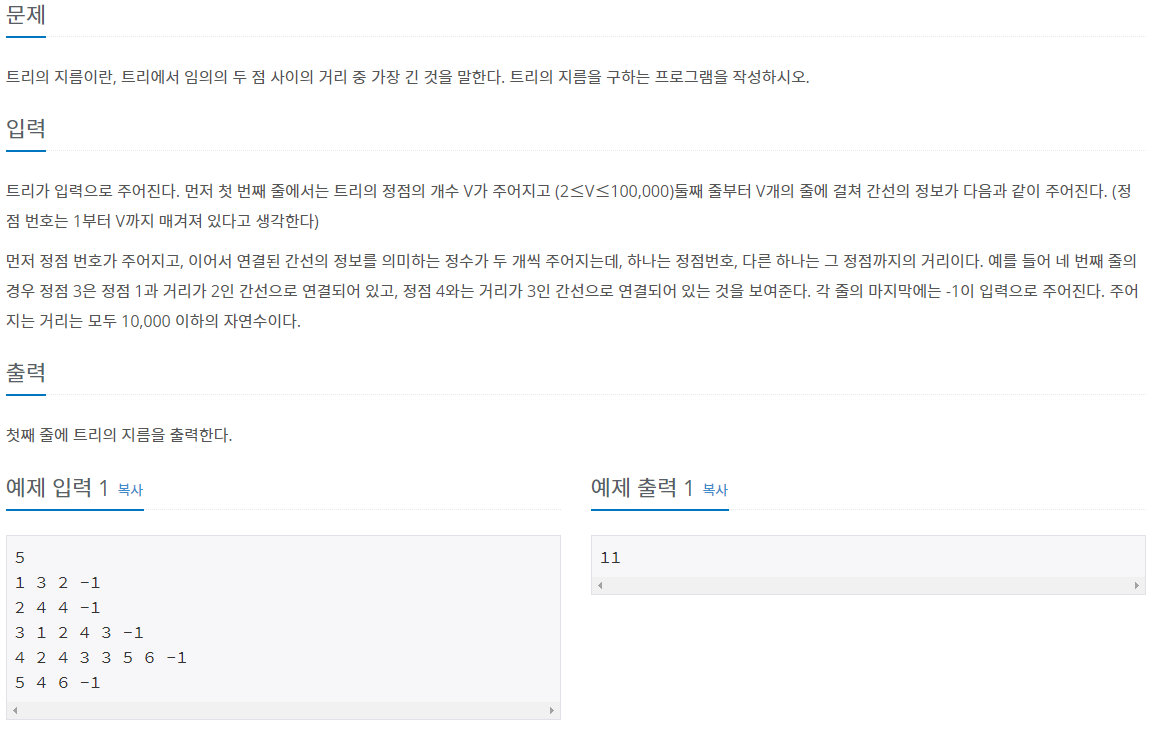solved.ac 백준 골드문제 포스팅
문제

DFS
깊이 우선 탐색, 그래프의 자식을 우선으로 탐색한다.
추후 다른 포스팅에서 BFS와 함께 정리 예정
접근법
백준-1967번-트리의-지름 문제와 접근법이 같다.
다만 이 문제의 경우 루트 노드를 주지 않았지만, 임의의 노드를 아무거나 찍고 그 노드에서 가장 멀리 떨어진 노드를 구하고, 구한 노드에서 또다시 멀리 떨어진 노드를 구하는 방식으로 접근하였다.
코드 - JAVA
import javafx.util.Pair;
import java.io.*;
import java.util.*;
class Main {
static int N = 0;
static ArrayList<Pair<Integer,Integer>>[] graph;
static boolean visit[];
static int max;
static int maxIndex;
public static void main(String args[]) throws IOException {
BufferedReader br = new BufferedReader(new InputStreamReader(System.in));
N = Integer.parseInt(br.readLine());
graph = new ArrayList[N+1];
for(int i=1; i<=N; i++){
graph[i] = new ArrayList<>();
}
visit = new boolean[N+1];
StringTokenizer str;
for(int i=0; i<N; i++) {
str = new StringTokenizer(br.readLine());
int parent = Integer.parseInt(str.nextToken());
while (str.hasMoreTokens()) {
int input = Integer.parseInt(str.nextToken());
if (input == -1)
break;
int value = Integer.parseInt(str.nextToken());
graph[parent].add(new Pair<>(input,value));
//주어진 입력이 양방향이라서 한번만 입력함
}
}
dfs(1,0);
int idx = maxIndex;
max = 0;
maxIndex = 0;
visit = new boolean[N+1];
dfs(idx,0);
System.out.print(max);
}
public static void dfs(int idx, int sum){
visit[idx] = true;
boolean flag = false;
for(Pair i:graph[idx]){
if(!visit[(int)i.getKey()]&&(int)i.getKey()!=0){
flag = true;
dfs((int)i.getKey(),sum+(int)i.getValue());
}
}
if(!flag&&max<sum){
max = sum;
maxIndex = idx;
}
}
}Pair
이전 문제에서도 그렇듯이 계속해서 JavaFX의 Pair를 사용하고 있다.
다른 언어에서 지원하는 Pair와 유사하고, 특별히 메모리를 사용하지 않아 자주 사용하고 있다.
사용법은 다음과 같다.
List<Pair<Integer, Integer>> pairs = new ArrayList<>();
pairs.add(new Pair<>(1,2));
pairs.get(0).getKey();
pairs.get(0).getValue();사실 Pair는 이름이 직관적이라 자주 사용하긴 했지만, 이는 JavaFx가 포함된 8에서나 사용할만하다.
AbstractMap의 SimpleEntry가 타 언어의 Pair와 거의 같다고 보인다.
- equals(Object o)
- getKey()
- getValue()
- hashCode()
- setValue(V value)
- toString()
위와 같은 함수들을 지원한다.
SimpleEntry 또한 Pair와 같은 형식으로 사용하면 된다.
